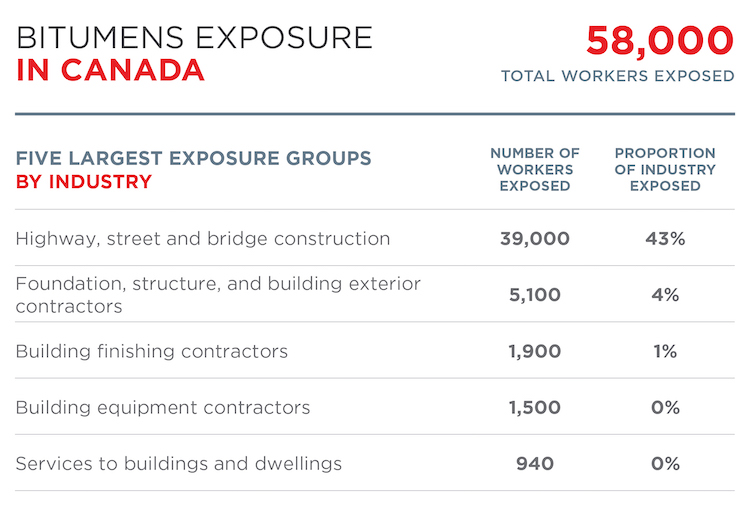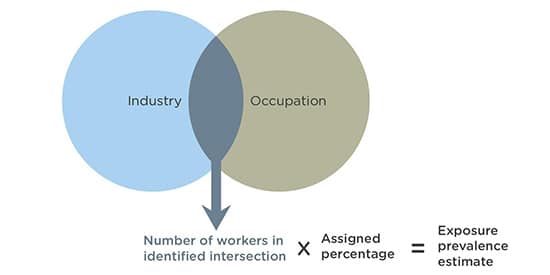Bitumens Occupational Exposures
Bitumens Occupational Exposures
Overview
Inhalation of bitumen fumes and dusts is the most important route of occupational exposure.[1] For bitumens used in cooler temperatures, such as cutback bitumens, blended bitumens, and bitumen emulsions, regular skin contact may also occur.[2] CAREX Canada estimates that approximately 58,000 Canadians are exposed to bitumens in their workplaces.
READ MORE...
The largest industrial groups exposed are highway, bridge, and street construction, followed by contractors in foundation, structure, and building exterior, finishing, and equipment.
The largest occupational groups exposed are construction trades helpers and labourers, followed by heavy equipment operators and roofers and shinglers. Other occupations potentially exposed to bitumens include those employed in refineries, asphalt mixing plants, and roofing material manufacturing,[2,3] as well as workers involved in transporting and storing bitumens.[1]
Strategies to reduce exposures include selecting the correct kettle type/size, using low fuming asphalt, and using temperature control devices to reduce asphalt fume emissions.[4]
Prevalence Estimate
Results show that 58,000 Canadians are exposed to bitumens in their workplaces; 94% of these workers are male. The largest exposed industrial groups are in the broad category of construction. This includes highway, bridge, and street construction, and contractors in foundation, structure, and building exterior, finishing, and equipment.
When exposure is examined by occupation, the largest occupational groups exposed are construction trades helpers and labourers (22,000 workers exposed), heavy equipment operators (15,000 workers exposed), roofers and shinglers (13,000 workers exposed), and contractors and supervisors for heavy equipment operator crews (5,800 workers exposed).
The number of workers exposed to bitumens increased by approximately 14,000 workers from 2006 to 2016 (a 32% increase). This was primarily driven by an increase in the number of workers in the construction industry, and in the number of roofers and shinglers.
Workers exposed to bitumens by industry in 2016

Workers exposed to bitumens by region in 2016
Click the second tab to view total number of workers exposed.
* = < 50 workers
Methods and Data
Our Occupational Approach page outlines the general approach used to calculate prevalence and exposure level estimates for workplace exposures.
Data Sources
Data used in developing the occupational estimates for bitumens were collected from several sources:
- The Canadian Workplace Exposure Database (CWED) contains approximately 300 measurements for bitumens exposure. These measurements were collected during the years 1984 to 1993 in Ontario workplaces.
- Canadian and US scientific peer reviewed publications that addressed bitumens exposure in Canada and the United States.
- Grey literature including technical reports from governments and international bodies, as well as industry reports on the paving and roofing industries.
Prevalence Estimate Method
CAREX defines exposure to bitumens somewhat differently than for other agents. In the most recent IARC monograph focusing on bitumens, exposure was defined as it links to specific jobs and tasks; therefore we have taken a very similar approach in our updated exposure estimates. We define exposure to bitumens in the following ways:
- Working with oxidized bitumens and their emissions during roofing;
- Working with straight-run bitumens and their emissions during road paving;
- Production of roofing and paving materials.
IARC does not include the production of roofing and paving materials, but this exposure scenario is mentioned often in the literature, and heating of the materials is very likely to occur in these settings and cause similar emissions, and thus similar exposures to workers. IARC does, however, include exposure during mastic asphalt work, but this is not known to occur in Canada so we have not considered it further in our estimates.1
Since a wide variety of compounds are released into the air when bitumens are heated, respiratory exposure to bitumens have been studied by measuring many agents. These agents include total particulate, volatile organic compounds, fumes released as cyclohexane- or benzene-soluble matter, and various PAHs. For this reason, there is likely to be some overlap between PAH exposure and bitumens exposure in our CAREX estimates.
To determine the number of workers potentially exposed to bitumens at work, CAREX occupational exposure experts used methods previously established in other peer-reviewed CAREX projects in Europe, in addition to new information available in the recent IARC evaluation of bitumens. A series of steps were taken to assign exposure proportions to occupations and industries at risk of exposure to bitumens.

- Occupations and industries at risk of possible exposure to bitumens were identified using any combination of data sources described above.
- The total number of workers in each identified occupation and industry intersection was obtained from Statistics Canada 2016 census data.
- A percentage of workers exposed was assigned to that occupation and industry intersection. Percentages were determined by consultation with existing evidence in the data sources, previously established methods from the Europe CAREX estimates and the expert judgment of CAREX occupational hygienists.
- The number of workers in the identified group is multiplied by the assigned percentage to calculate the prevalence estimate of workers exposed to bitumens.
1. EMAA/HSE Working Group. The Mastic Asphalt Industry – A Global Perspective. 2010.
Sources
Subscribe to our newsletters
The CAREX Canada team offers two regular newsletters: the biannual e-Bulletin summarizing information on upcoming webinars, new publications, and updates to estimates and tools; and the monthly Carcinogens in the News, a digest of media articles, government reports, and academic literature related to the carcinogens we’ve classified as important for surveillance in Canada. Sign up for one or both of these newsletters below.
CAREX Canada
School of Population and Public Health
University of British Columbia
Vancouver Campus
370A - 2206 East Mall
Vancouver, BC V6T 1Z3
CANADA
As a national organization, our work extends across borders into many Indigenous lands throughout Canada. We gratefully acknowledge that our host institution, the University of British Columbia Point Grey campus, is located on the traditional, ancestral, and unceded territories of the xʷməθkʷəy̓əm (Musqueam) people.



